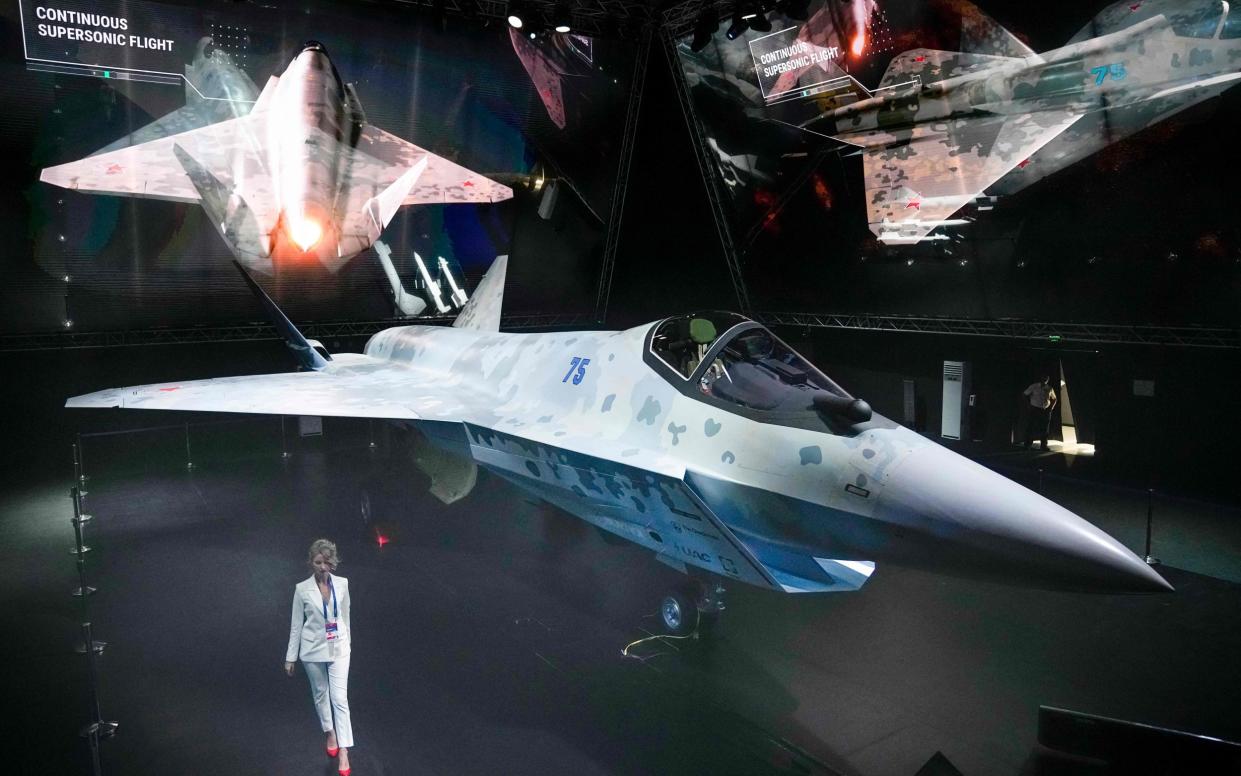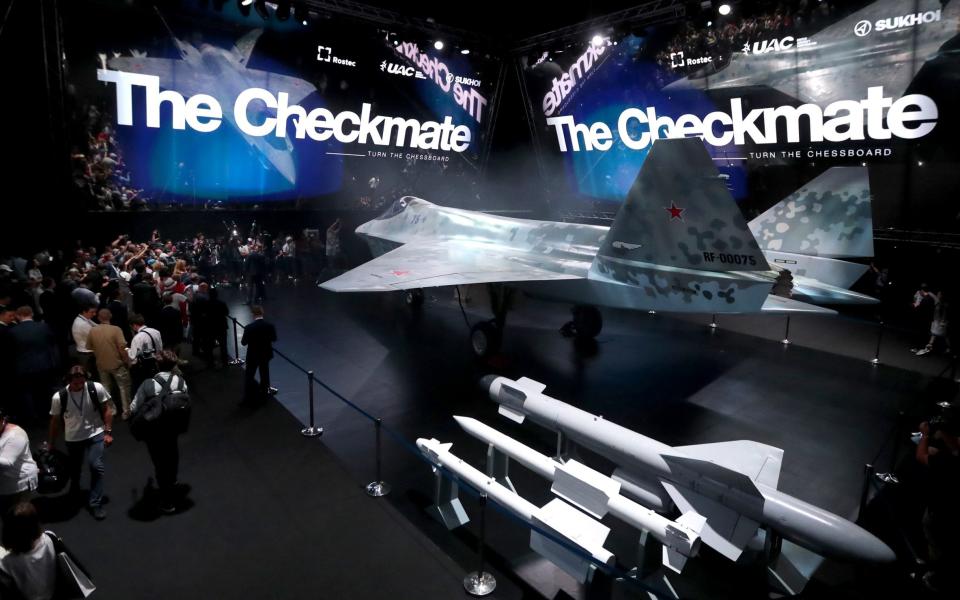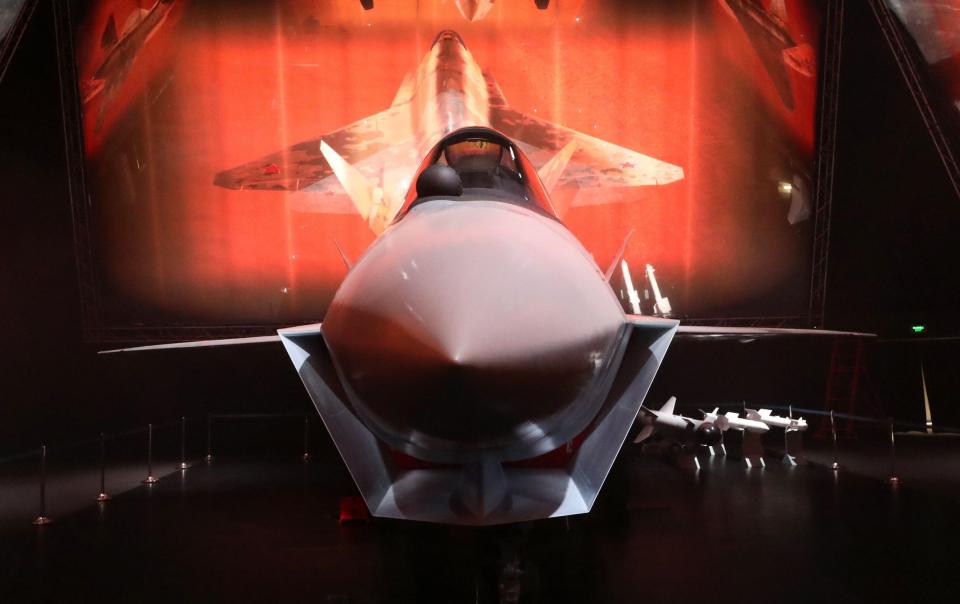Russia unveils new stealth fighter as Vladimir Putin builds 'invincible' arsenal

- Oops!Something went wrong.Please try again later.
Russia has unveiled a stealth fighter jet named “Checkmate” as Moscow steps up military testing amid increased tensions with the West.
President Vladimir Putin inspected the much-vaunted aircraft, which state manufacturer Rostec hopes to sell to foreign markets, at a trade show outside Moscow this week.
The next-generation Sukhoi fighter is able to reach twice the speed of sound and can be converted to an unpiloted version, according to its designers, who aim to begin deliveries by 2026.
The launch of the plane was accompanied by a provocative advertising campaign, which played on a recent standoff between a British warship and the Russian military in the Black Sea.


In one advertisement, the Royal Navy’s HMS Defender featured alongside the slogan “See You”. In another, the Checkmate appeared under black tarpaulin, with the question: “Wanna see me naked?”.
The unveiling came just days after Russia tested a hypersonic missile, part of a growing arsenal that Mr Putin has described as “invincible”, and analysts say is fuelling a new arms race.
Moscow’s defense ministry on Monday announced it had fired the Tsirkon cruise missile at a target on the northern Barents Sea, with the weapon travelling some 200 miles at more than seven times the speed of sound.
Nuclear capable systems
The Pentagon said such missiles, which could be used to target Western navy destroyers in a potential conflict, “are potentially destabilising and pose significant risks because they are nuclear capable systems”.
Moscow has already carried out several tests of the Tsirkon, including one firing last year that Mr Putin described as a “great event not just in the life of our armed forces but for all of Russia.”
More tests are set for next month, and Russia eventually plans to equip both warships and submarines with the weapon.
Mr Putin has in recent years announced a number of new weapons that he claims can circumnavigate existing defense systems and have left the West “playing catch-up” with Russia.
They include Avangard hypersonic missiles, which were deployed in 2019. “The Avangard is invulnerable to intercept by any existing and prospective missile defence means of the potential adversary,” the Russian president said at the time.
Also this week, the Russian military released the first footage of a live fire test of its S-500 Prometheus missile system, which it said was “objectively unlike anything in the world” and could protect from attacks from space.
Moscow’s flaunting of its hardware follows increasingly aggressive rhetoric from the Kremlin, with Mr Putin promising a “fast and harsh” response if any foreign country was seen to be crossing Russia’s “red lines”.
But Pavel Felgenhauer, a Russia-based military analyst, poured some cold water on Moscow’s claims of its capabilities.
Mr Felgenhauer said that the military was still operating with Soviet-designed equipment and a "Soviet mentality,” which prized size over genuine innovation, and spoke of a “technological gap” between Russia and the US.
The test of the Tsirkon was “a gift for the Pentagon” as Washington reviews its military spending, he told The Telegraph.
“There has to be a threat to convince people to spend on weapons,” he said.
The administration of US President Joe Biden has already asked for increased funding for research into hypersonic technology, requesting some $3.8 billion for 2022, up from $3.2 billion on the previous year. China has also been developing hypersonic weapons for the last decade.
Putin 'trying to scare' the West
Mr Felgenhauer said Moscow was developing such equipment primarily as a deterrence, to convince the US and other Western countries that it was not worth getting involved in what Russia considers its field of influence.
“Putin is trying to scare [the US and Europe], so that when Moscow goes, for example, for Ukraine, the West will sit on the sidelines.”
Russia last month tested a giant new nuclear submarine, the largest developed anywhere in the world in three decades.
Moscow said the Belgorod submarine would not only act as a mothership for smaller vessels that could cut vital cables on the seafloor, but also carry six Poseidon nuclear torpedoes.
Russia is currently developing the Poseidon, which it says is a long-range, nuclear-powered autonomous torpedo, potentially capable of destroying coastal cities.
Mr Felgenhauer described the technology as “unethical” as it is aimed at civilian populations and would cause mass loss of life.
But Pavel Luzin, an independent military analyst, suggested it would be “physically impossible” to deploy the Poseidon. Moscow had vaunted its development for propaganda rather than practical purposes, he said.
Mr Luzin added that Russia’s sabre-rattling was designed to make up for shortcomings in other areas.
“Russia tries to be a superpower without enough economic capacity, without enough technological capacity, without enough human capital,” he said.
“The only capital of Russia is military capital, and that’s why Russia puts a lot of attention and spends a lot of money on global military capabilities.”

